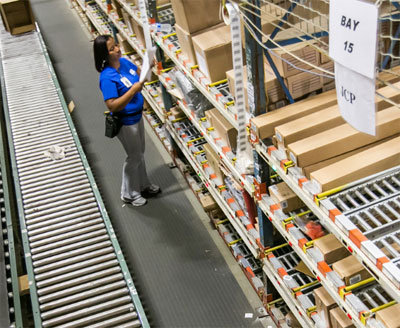10 Ways to Reduce Inventory Errors Through Order Picking
Identify the root causes of order picking mistakes

Mistakes happen, but in order picking operations, reducing the number of errors is critical. Because order picking is the last touch point between you and your customers, it’s more important than public relations, press releases, or your website. Whether you’re shipping direct to consumers or to another processing operation, customers are directly impacted. Not only is the customer with the incorrect order harmed, so are potential future customers who suffer because of inventory errors delaying orders.
What are some ways you can increase inventory accuracy related to order picking?
1. Track order accuracy rates
If you can’t recite your accuracy numbers for any recent interval, you aren’t tracking well or often enough. Whatever your beliefs are about your operational efficiency, unless backed by data, they’re probably wrong. Some easy things to track are returns, customer complaints, and inventory comparisons.
2. Identify the “slow kid” in your process
It could be that there are a few key flawed components that hold back the entire operation. In one of the more classic examples of product flow, a Scoutmaster noticed that as his troop marched to campsite, the lines got skewed because there was a slow kid in the middle of the pack who couldn’t consistently keep up the pace. His solution? Put the slow kid up front so that all the scouts arrived at the campsite simultaneously and in good order. In your order picking operation, what area is the slow kid that’s causing errors? Is it full or broken cases–or both? How are the pick locations marked? Are order pickers in the right zone at the right time? Are the right products slotted into the right pick locations? Do you execute cycle counts so errors don’t crop up unnoticed? This is a process of elimination that eventually helps you figure out where the problems are – and aren’t.
Order fulfillment and the customer experience it creates is your public face in every meaningful way.
3. Realize that the slow kid isn’t always (or even usually) a person.
There are good employees, the kind who are a joy, and there are awful employees, the kind you must remove as quickly as possible. The vast majority of people are in the middle, and they can be materially affected by your setup, product slotting, storage/handling equipment, WMS system, or lack of it, and everything in between. Helping those mid-level performers improve by process, layout, and equipment will yield better results than a focus on personnel. You can improve personal performance through tracking, process, and discipline, but they can only be as good as your systems allow. You’ll never eliminate human error, but you can minimize it. You can make the average worker into a good worker.

4. Execute cycle counts
Cycle counts are like a good multivitamin: you’ll benefit from a number of angles. In terms of inventory errors, they’ll start to help you shape the picture you need to track down the problems in your operation.
5. Automate anything that makes operational and economic sense
Not every application or facility is suited for automation, but people can and do create more efficient operations with more accurate inventory counts through automation, and it’s not as expensive or difficult as it was ten years ago. The costs of robotics, WMS, and other pieces of the puzzle have held steady, or in some cases declined while the costs of labor, energy, and real estate have inflated. Solutions such as robotics, WMS, carousels, pick-to-light and AS/RS are not out of reach.
One thing to remember is that automation usually doesn’t start with an entire facility. It’s smart to identify high-ROI applications, and build around those to maximize impact.

6. Count after picks
Count as many times as reasonable. If you can, count before picking, and recount after. Shippers and packers can count the order before it ships, giving the picker a quick double-check. And if the shipper is a different person, they should count before sending it. Doing these quick counts sounds time-intensive, but the errors you can eliminate may make it worthwhile. If time is money, the time you spend counting will prevent dissatisfied customers, incorrect counts, and headaches due to not understanding your true stock situation. Even a few returns can consume more time than the returns you might prevent with systematic recounts.
7. Don’t make your pick lists difficult or confusing
The most common is a mix-up of full and partial case picks. Pickers who can pick either the full carton or pieces may mix up the order and pick single items rather than a full box, or vice-versa. Either way it can result in shortages or overages that will skew your inventory. Picklist and invoice descriptions, in particular for full or partial picks should be crystal clear. The SKU’s should be modified if possible so that they aren’t similar.
If feasible, consider light-directed or voice directed systems that reduce or eliminate pick tickets.
8. Eliminate walking and reduce fatigue for more accurate picks
You make more mistakes when you’re tired, and so do your order picking employees. Try to keep them still, not moving and you’ll see faster picks with fewer errors (how much? – see gravity flow vs. shelving comparisons). Utilizing solutions such as carton flow racks, which deliver product to pickers and reduce walk times can keep people fresher and more capable of doing the job right. Typically an order picker should spend more of his time picking than moving to picks, and that may not require expensive facility redesigns or automation. It may require 5-S principle applications, product slotting reconfiguration, and intelligent materials storage.
9. Look upstream
The problem may be in receiving or elsewhere. Don’t assume your inventory errors all start with pickers. Many times, they don’t. The issue could be in receiving (which is a critical area for inventory accuracy), material handling, replenishment, data entry, or even shipping. When a receiving employee receives a shipment he should verify the receivables before signing off. A second employee should put the stock away, and again re-count and verify. This gives you a quick, easy double count before a single order is picked. No count should go unchecked, and no one should be responsible for checking his own count.
10. Go pareto
If your operation is like most, you’ll see the 80/20 dynamic in action. Applying it to stocking, counting, and shipping can pay dividends. If you have a theoretical ten cases of product, two of which are the most frequently accessed, count those SKU’s daily or hourly. Count your second tier products less frequently; weekly or monthly.
Related articles:
- Order Picking Error Rates: What’s Acceptable?
- 10 Ways to Improve Order Picking Productivity
- Warehouse Ergonomics: A Quick Guide
Tags: inventory accuracy
Scott Stone is Cisco-Eagle's Vice President of Marketing with 35 years of experience in material handling, warehousing and industrial operations. His work is published in multiple industry journals an websites on a variety of warehousing topics. He writes about automation, warehousing, safety, manufacturing and other areas of concern for industrial operations and those who operate them.



